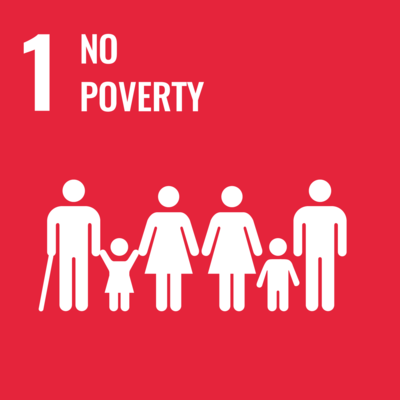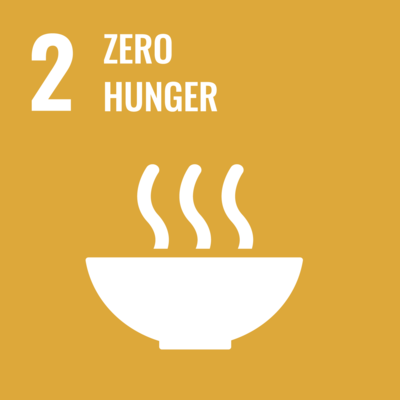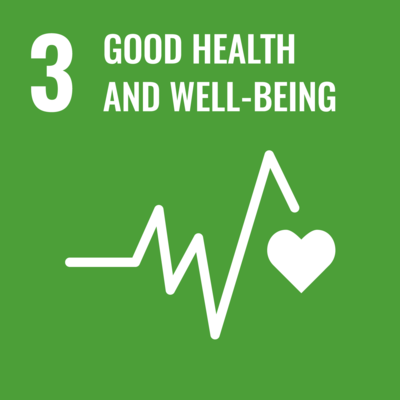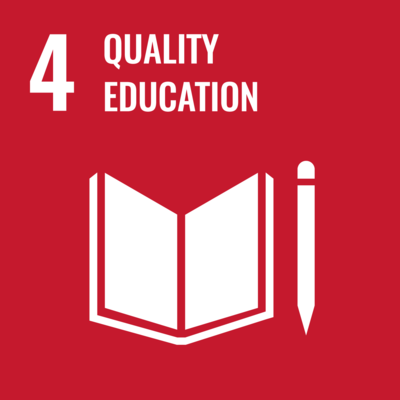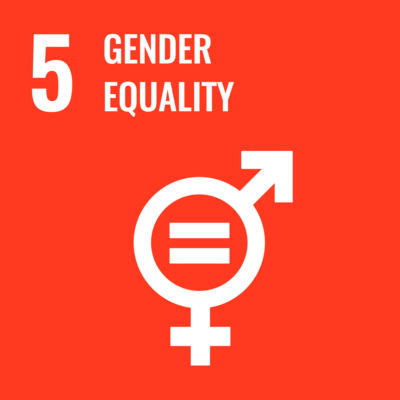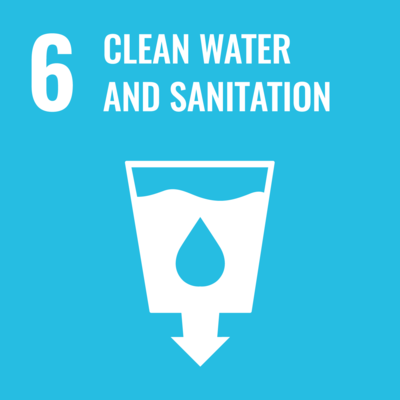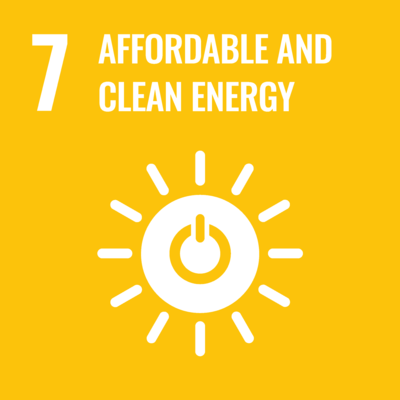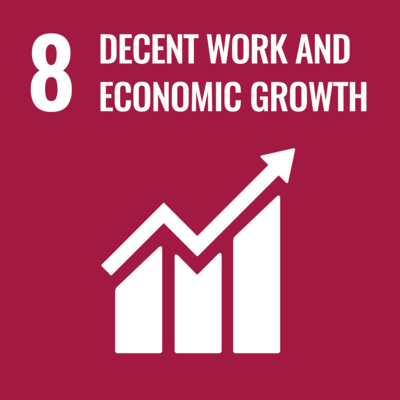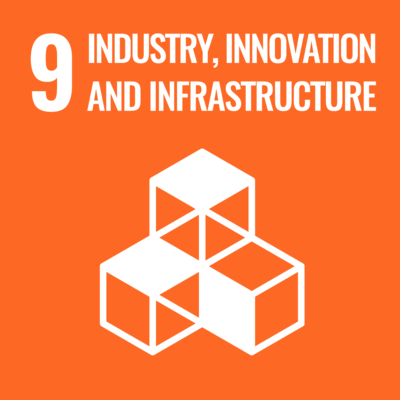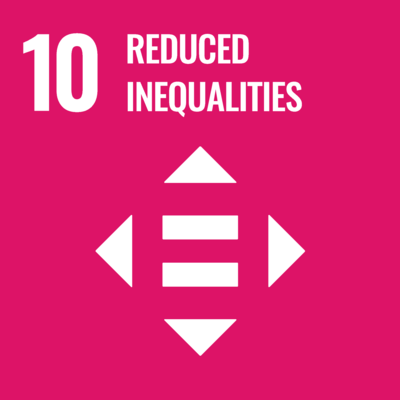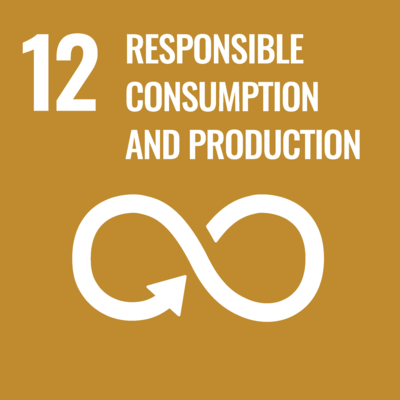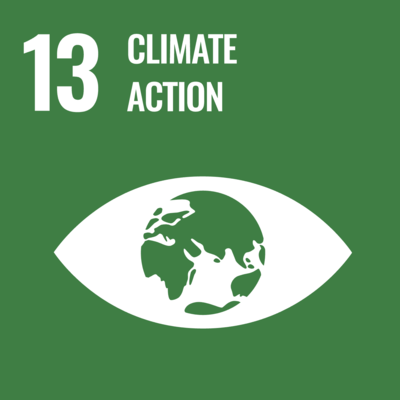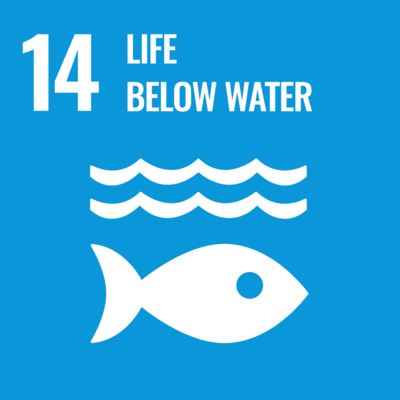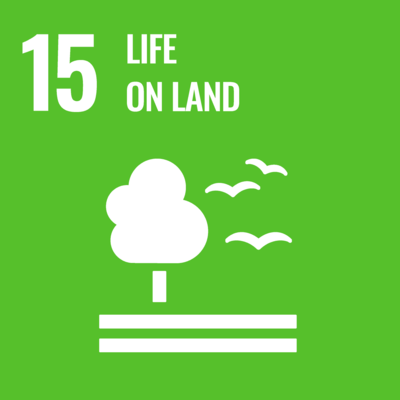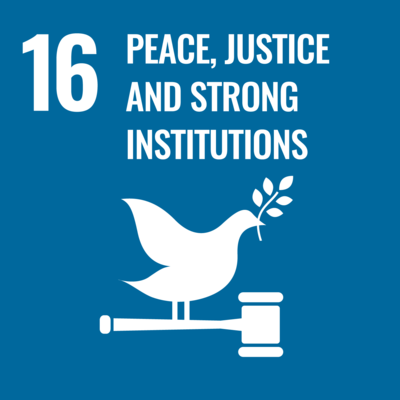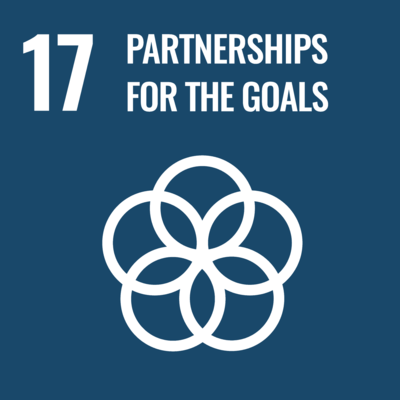SDG 13.3.2 Climate Action Plan, shared
1. NCUE's faculty members have executed National Science and Technology Council projects, providing advice and assistance for local or regional governments' future planning of agricultural production systems, disaster prevention, and water resource allocation, as shown in Table 1.
Table 1. Project Number, Principal Investigator, and Project Name
|
No. |
Principal Investigator |
Project name |
|
1 |
Professor Jien-yi Tu |
Impacts of Large-scale Circulation Changes on Precipitation in the Asian Monsoon Region under Global Warming (Appendix 13.3.2A-Report on Results) |
Project description is as follows:
This study primarily investigates the seasonal, interannual, and long-term trends of rainfall in the Asian monsoon region. Results indicate that strong monsoon years are typically accompanied by low-level air convergence, with large amounts of moisture transported into the monsoon region, leading to increased precipitation. Weak monsoon years are characterized by air divergence, with high-pressure anomalies providing more stable atmospheric conditions, resulting in reduced rainfall. From a seasonal variation perspective, the “dry seasons get drier, wet seasons get wetter” pattern of seasonal rainfall changes is mainly observed in the East Asian monsoon region. The South Asian and Northwest Pacific monsoon regions show an increasing trend in dry season rainfall, with sea surface temperature changes and associated atmospheric circulation playing crucial roles. The research findings help us better understand the potential impacts of monsoon circulation changes on precipitation in monsoon regions, which is beneficial for Taiwan's future disaster prevention and water resource allocation. (Figures 1-4)
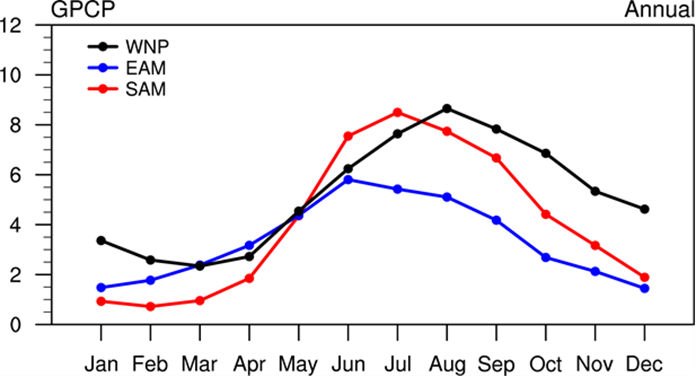
Figure 1: Annual cycle of rainfall in three Asian monsoon subsystem regions. Red, blue, and black lines represent rainfall in the South Asian, East Asian, and Northwest Pacific monsoon regions, respectively.
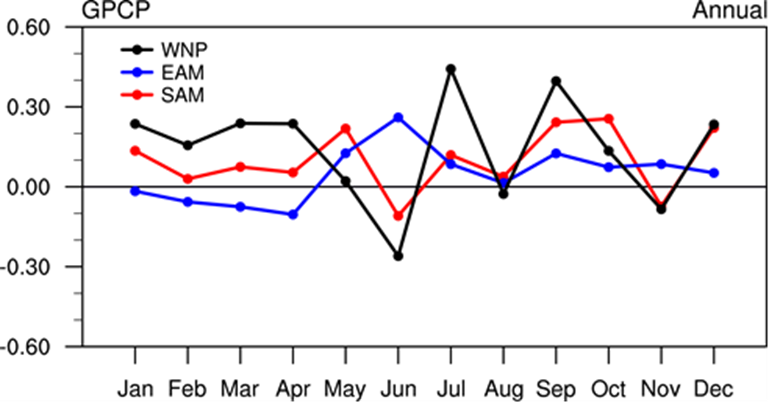
Figure 2: Annual cycle of monthly precipitation trends in the three monsoon sub-regions.

Figure 3: Five-year moving average time series of wet season precipitation in the three monsoon sub-regions.
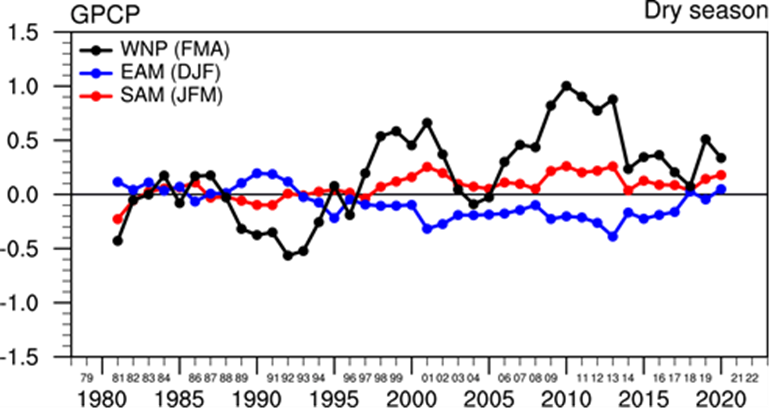
Figure 4: Five-year moving average time series of dry season precipitation in the three monsoon sub-regions.
2. NCUE has five ongoing collaborative environmental education project activities, as shown in Table 2. Brief descriptions for each are provided below.
Table 2. Projects Related to Environmental Education
|
No. |
Programme |
|
1 |
Beautiful and Treasured Clams in Fangyuan and Dacheng: Sustainable Industry and Environment Project of Changhua’s Two Cities Amid Climate Change project |
|
2 |
Taoyuan International Airport Corporation Program/ Commissioned Planning and Design for Invasive Red Fire Ant Control Operations |
|
3 |
Ministry of Science and Technology / Commercialization Model of Integrated Pest Management Technology for Ant Control |
|
4 |
Animal and Plant Health Inspection Agency, Ministry of Agriculture / Expansion of Drone-Based Management System for Invasive Fire Ant Control and Agricultural Pesticide Application |
|
5 |
Program for Kenting National Park/Investigation on the Invasion and Control Strategy of Yellow Crazy Ants in Kenting National Park |
(1) “Beautiful and Treasured Clams in Fangyuan and Dacheng: Sustainable Industry and Environment Project of Changhua’s Two Cities Amid Climate Change" Project: This project promotes environmental education, introduces eco-friendly practices, air pollution awareness, beach cleaning and wetland conservation, energy conservation and carbon reduction, product packaging, and marketing research and practical experiences to assist in addressing local environmental protection and aquaculture development issues.
(a) The research project includes collaboration with the Changhua County Aquaculture and Fisheries Development Association to develop strategies for climate change adaptation. In addition to serving and surveying the Changhua Aquaculture Association's fish ponds, coastal water intake channels, and groundwater wells, the project has expanded its scope based on stakeholder feedback from the USR project. This includes serving golden clam producers and surveying additional areas, such as the upper, middle, and lower reaches of rivers that serve as water sources for fish ponds. The project aims to maintain and monitor the safety of water resources for aquaculture operators and coastal areas. All these services are provided free of charge. Related activity photos are shown in Figures 5-6.
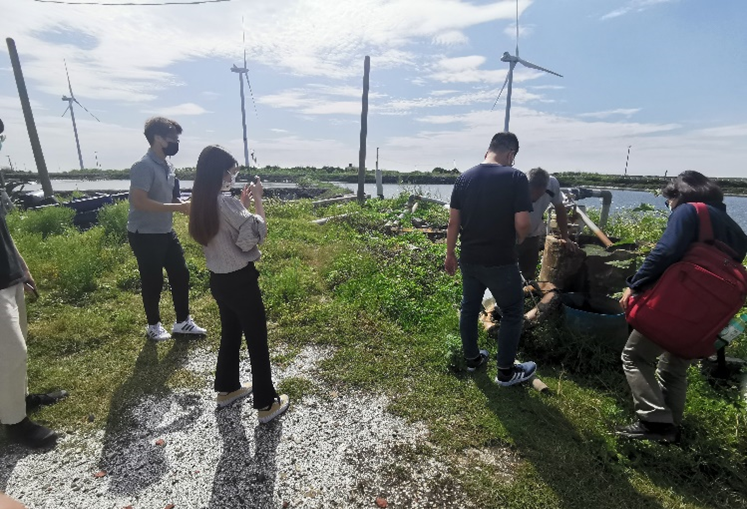
Figure 5. Conducting on-site investigations
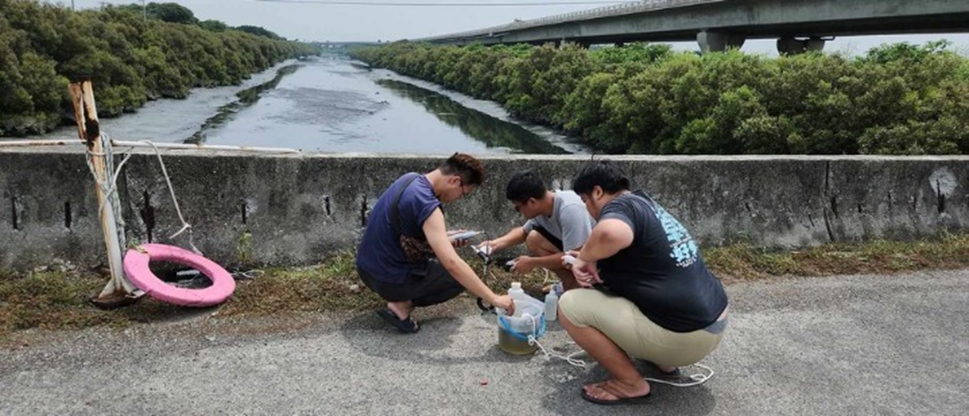
Figure 6. 2023/06 Water Quality Survey Team - The Department of Biology's 2023 USR project implementation, investigating water quality in the upper, middle, and lower reaches of rivers.
(b) "Sustainable Development and Practices of Coastal Biological Resources": The course includes workshops on "The Application of Beneficial Bacteria in Aquaculture" and "Aquaculture and Greenhouse Gases". Participants include course students, teachers, local aquaculture operators, and organizations, working together to maintain the health and sustainability of local aquatic ecosystems. Related activity photos are shown in Figure 7.
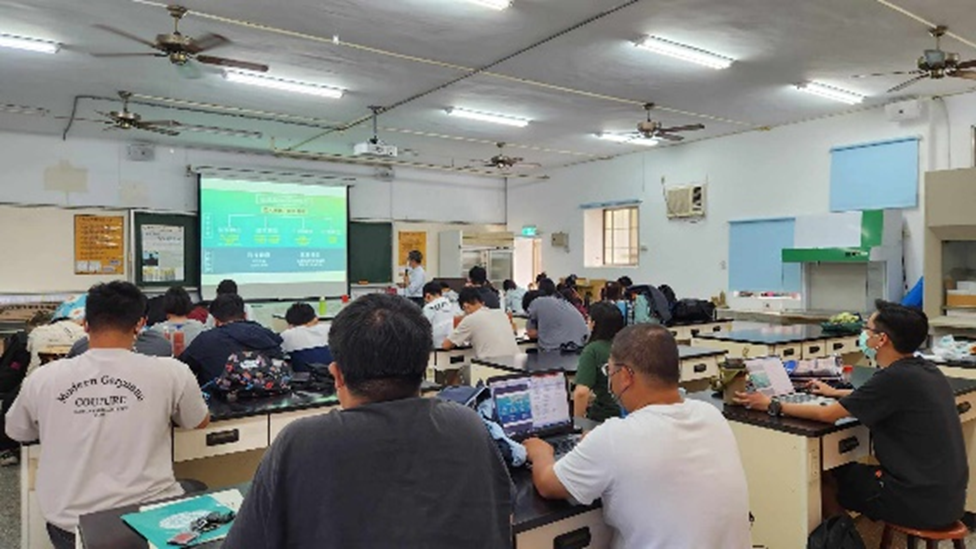
Figure 7. 2023/04 "Aquaculture and Greenhouse Gases" course, with participants ranging from students, teachers, to local aquaculture operators and organizations, promoting environmentally friendly low-carbon production strategies to maintain the health and sustainability of local aquatic ecosystems.
(c) Clam farming is an environmentally friendly aquaculture practice that can absorb carbon dioxide and reduce greenhouse gases, thereby lowering carbon emissions. The ecosystem-based polyculture method reduces feed usage, water consumption, and waste production. Combined with smart aquaculture techniques and cloud-based AI big data analysis, it lowers risks and improves quality and yield. This forms the core of innovative teaching that links research, coursework, and student learning services, integrating with in-depth aquaculture tourism development and operations in fishing villages. This creates new value for NCUE and local industries in urban and rural development. Related activity photos are shown in Figure 8.
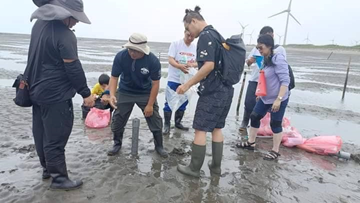
Figure 8. NCUE's faculty and students, along with local community members, conducting coastal surveys to establish a marine ecology database and monitor information related to economic fishery resources.
Project activity Facebook fan page link:
https://www.facebook.com/NCUEUSR/photos/?tab=album&ref=page_internal
(2) Taoyuan International Airport Corporation Project / Commissioned Planning and Design for Invasive Red Fire Ant Control Operations (Figure 9).
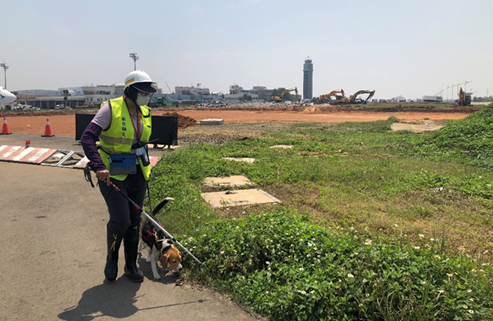
Figure 9: NCUE Taoyuan International Airport Fire Ant Control Team using fire ant detection dogs to assist in searching for invasive red fire ants at Taoyuan Airport.
(3) Ministry of Science and Technology Project / Commercialization Model of Integrated Pest Management Technology for Ant Control (Figure 10).
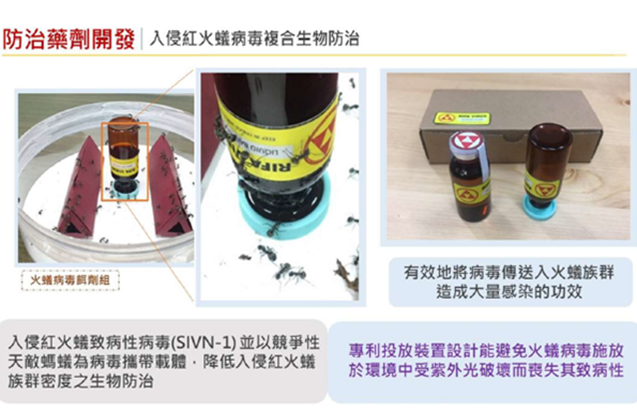
Figure 10: Development and application of microbial control for the increasingly severe problem of harmful ants in agricultural environments. The project focuses on the design, development, and application research of microbial pesticide technology for harmful ants on crops, as well as developing its practical value and commercial potential.
(4) Animal and Plant Health Inspection Agency, Ministry of Agriculture / Expansion of Drone-Based Management System for Invasive Fire Ant Control and Agricultural Pesticide Application (Figure 11).

Figure 11: Assisting in establishing guidelines for using agricultural drone-based systems to distribute pesticides in large areas or on challenging terrain.
(5) Program for Kenting National Park/Investigation on the Invasion and Control Strategy of Yellow Crazy Ants in Kenting National Park. Assisting Kenting National Park in surveying the invasion status of the Yellow Crazy Ant (Anoplolepis gracilipes), one of the world's 100 worst invasive species, in land crab distribution hotspots. This study can be considered the first case in East Asia to discover the threat of Yellow Crazy Ant invasion on land crab populations. In addition to ant pests, land crabs also face threats from road kills, habitat destruction, and human capture (Figure 12).
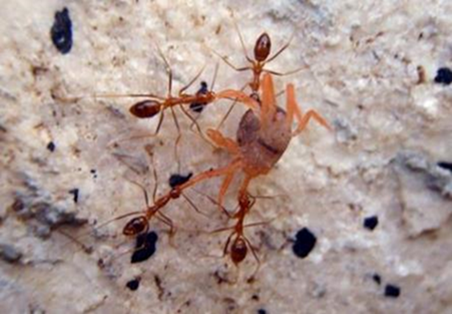
Figure 12. Yellow Crazy Ants attacking a juvenile crab

